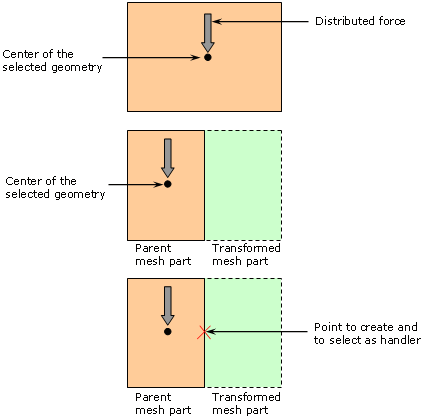More About Distributed Force | ||||
|
| |||
Distributed Force Behavior
To distribute uniformly forces on supports, we recommend to use force densities or pressures. The behavior of the distributed force can be simulated by creating a smooth virtual part with the same support as the distributed force and applying a punctual force on its handler.
Therefore, the results depend on the meshing and all nodes are considered equally in the distribution. A distributed force is applied directly to the nodes of the selected entity, whereas a surface force density or a pressure is applied to the element faces of the selected entity. The latter type of forces is far more accurate and should be used whenever equivalent to the distributed force.
For example, consider a coarsely meshed cylinder whose top
surface has been subjected to a distributed force and whose bottom
surface is clamped. The nodes on the edges have fewer neighbors
than the inner nodes; therefore, they are pulled a lot further than
the inner nodes, which leads to an erroneous result near the edges.
Mesh refinement is needed to get the proper results.
The same configuration leads to a smoother and more accurate
displacement if you replace the distributed force by a surface
force density.
![]()
Point of Application
Depending on the support type, the distributed force is applied differently.
The point of application of the force resultant is defined
automatically as follows:
- For extended geometries, this point is the center of the geometry.
Warning: In the case that the selected geometrical support is referenced by several meshess (such as transformed meshes), the default handler point is still computed with respect to the geometry. In this case it is strongly recommended that you select a user-created handler point. 
- For virtual parts, this point is the handler of the virtual part.
The given single-force system is processed as follows:
- In the case of extended geometries, it is transformed into an equivalent force system distributed over the selected support.
- In the case of virtual parts connected to deformable bodies, it is transmitted as a force system collectively to the entire connected geometry.